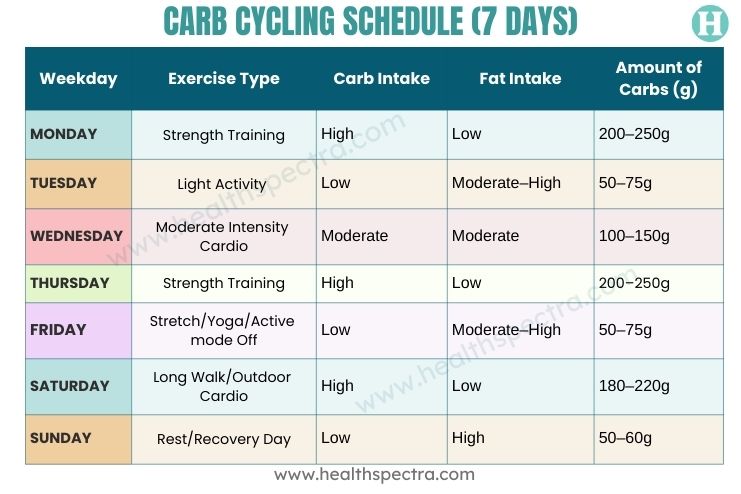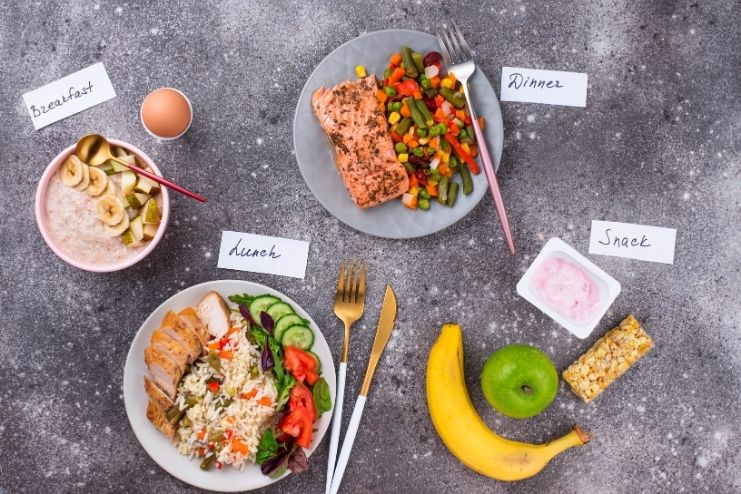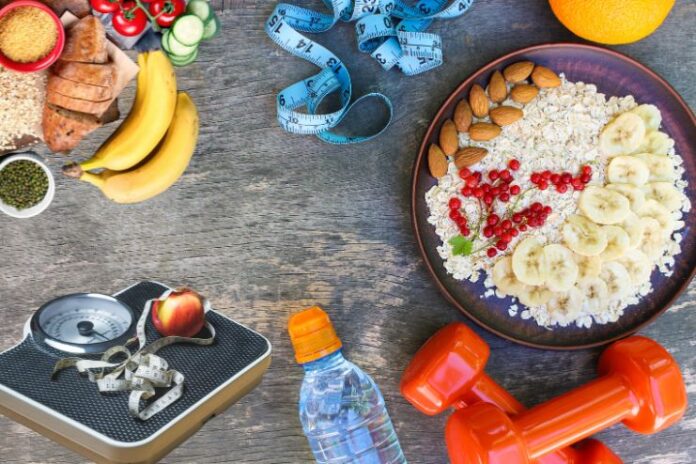Want to lose weight without swearing off bread or pasta? Carb cycling is a flexible eating approach that varies your carbohydrate intake from day to day. On high-carb days, you fuel your body and support muscle growth; on low-carb days, you reduce intake to encourage fat burning.
This approach balances energy, preserves muscle, and supports gradual weight loss without severe deprivation. Most individuals think they must eliminate carbs entirely to lose weight, but that is not the case.
Studies indicate that you can continue to burn fat while consuming carbs, provided you control when and how much you consume. Carb cycling also keeps your metabolism running and makes it easier to maintain healthy eating in the long term.
Unlike rigid low-carb or keto diets, carb cycling allows you to indulge in the foods you love, such as pasta or rice, on the right days. It’s all about timing and moderation as opposed to elimination.
Read More: A Healthy Pasta Alternative
What Is Carb Cycling?

Carb cycling is a smart nutrition plan in which you alter the amount of carbohydrates you consume daily or weekly based on your activity level and fitness objectives. Rather than consuming the same amount daily, you tailor your carbs to the needs of your body.
Carb cycling for weight loss is popular because you can lose weight without cutting carbs entirely, and it is easier to maintain a healthy diet plan.
How Carb Cycling Works
One popular method of carb cycling is by alternating high-carb and low-carb days according to your workouts.
- High-carb days are for heavy workout days when your body requires additional fuel to perform and recover well.
- Low-carb days are for rest days or light activity days to promote fat loss, with carbs still being part of your diet.
- Some plans may also incorporate moderate-carb days or refeed days to increase metabolism and avert fatigue or cravings.
Who Can Benefit from Carb Cycling?
You can tailor carb cycling to your goals—whether that’s burning fat while still including carbohydrates, building lean muscle, or boosting metabolic flexibility to burn either carbs or fats for fuel.
It suits athletes, fitness enthusiasts, and anyone seeking a realistic, flexible approach to improve their eating habits.
Read More: 7 Low-Carb Healthy Dinner Recipes
How Carb Cycling Supports Weight Loss

Carb cycling is a convenient and versatile eating strategy that enables you to lose weight without eliminating carbs completely. It’s a matter of alternating between high-carb and low-carb days based on your activity level.
Mastering how to carb cycle can aid in fat loss, boost energy, and enhance long-term diet success. Here’s an overview of the major carb cycling benefits:
Helps Manage Insulin Sensitivity
On low-carb days, your insulin level goes down, and your body becomes more efficient at burning fat. This is wonderful for insulin sensitivity and weight loss. On high-carb days, your glycogen levels get replenished, providing energy and increasing the metabolism.
With this balance, your body can process carbs more efficiently and minimize fat storage in the long run.
Preserves Muscle Mass
Carbs are necessary for workout performance and recovery. Timing carbs on training days (muscle gain and carb timing) assists your body in building and preserving muscle.
High-carb days facilitate muscle protein synthesis, avoiding the muscle loss commonly associated with low-carb diets.
Reduces Fat Storage
By controlling carb consumption as per how active you are, your body burns carbs as fuel rather than storing them as fat.
If you can determine when and how you consume carbs, it will help minimize fat accumulation and enhance body composition.
Boosts Metabolism and Hormonal Balance
High-carb days also aid in normal hormone function, particularly leptin, cortisol, and thyroid hormones. Hormones impact the level of hunger you experience, the way your body responds to stress, and how quickly your metabolism moves.
Maintaining the hormonal balance with intelligent carb cycling prevents plateaus and accommodates the metabolic flexibility approach.
Prevents Diet Fatigue and Cravings
One of the most appealing things about carb cycling is its flexibility. You can still have your carbs, just in a more strategic way. This keeps you consistent without making you feel deprived, so you’re more likely to stick to your plan over time.
Read More: Carbs, Their Importance, and Benefits
7-Day Carb Cycling Schedule
 How to Use This Schedule
How to Use This Schedule
This beginner carb cycling plan uses a balance of high, moderate, and low-carb days to match your activity level.
- High-Carb Days: Best for strength training and long activity days. Eat complex carbs like oats, whole grains, beans, fruits, and sweet potatoes. These help restore glycogen and improve performance.
- Low-Carb Days: Ideal for rest or light movement. Focus on leafy greens, non-starchy veggies, nuts, and healthy fats like avocado or olive oil.
- Moderate-Carb Days: Great for active recovery or medium-intensity cardio. Combine small portions of whole grains with lean proteins and healthy fats.
- Protein: Keep protein intake steady across all days to maintain muscle and support fat loss.
This carb cycling schedule helps you manage energy, reduce cravings, and see better results by adjusting your fuel, not cutting it out.
Read More: Exercise Snacking Can Help You Stay Fit
Best Types of Carbs to Include

Carb cycling is all about choosing the right carbs on the right days. Whether you’re exercising or resting, focusing on quality carbs can make your plan more effective and sustainable. If you’re starting out, initially, you can follow this carb cycling plan.
High-Carb Days
These are the days when you’re more active—doing strength training, cardio, or intense workouts. Fuel up with healthy carbs for fat loss and energy like:
- Whole grains (quinoa, oats, brown rice)
- Fruits (bananas, apples, berries)
- Starchy vegetables (sweet potatoes, corn, peas)
- Legumes (beans, chickpeas, lentils)
These complex carbs digest slowly and help keep blood sugar stable while providing energy and nutrients.
Low-Carb Days
On rest days or light activity days, scale back on carbs while still eating fiber-rich foods:
- Leafy greens (spinach, arugula)
- Non-starchy vegetables (zucchini, bell peppers, broccoli)
- Nuts and seeds
- Small amounts of berries
These foods support insulin sensitivity and weight loss, keeping you full without spiking blood sugar.
Avoid
To get the best results, limit:
- Sugary drinks and soda
- Processed snacks and fast food
- White bread, pastries, and candies
Read More: Silent Workouts: Are They Effective?
Who Should Try Carb Cycling?

Carb cycling is a flexible eating plan that adjusts your carbohydrate intake based on your activity level. It can be a great option for people who want results without completely giving up carbs.
Here’s who might benefit most from strategic carb intake:
Ideal For:
- Women and men trying to lose fat without going keto: You can still enjoy your favorite carbs while using healthy carbs for fat loss on high-carb days and cutting back slightly on rest days.
- Active individuals and gym-goers: Carb cycling helps fuel workouts with more carbs on training days, and promotes fat burning with fewer carbs on recovery days.
- People who want flexibility with carbs while maintaining results: This method avoids extremes and focuses on strategic carb intake, helping you enjoy carbs without sacrificing progress.
- Those seeking better body composition and energy levels: High-carb days support performance, while low-carb days help the body use fat as fuel more effectively.
Not Ideal For:
- People with a history of eating disorders: Regularly switching carb levels can lead to an obsession with food or numbers.
- Those with blood sugar issues (like diabetes): Fluctuating carbs may make it harder to manage glucose levels without professional guidance.
- Individuals with thyroid conditions: Low-carb days might interfere with thyroid hormone production, so consult your doctor before trying this method.
- Anyone not willing to track or plan meals: Carb cycling involves some meal planning and awareness to be done safely and effectively.
When done right, carb cycling offers the best of both worlds: healthy carbs for fat loss and enough fuel for active days. It’s about finding the right balance that fits your body, lifestyle, and goals.
Read More: Isometric vs Dynamic Exercises
Final Tips for Getting Started

Carb cycling is a more flexible eating technique that can enhance weight loss, energy, and performance without avoiding carbs altogether. Below are some useful tips that will help you start the carb rotation diet and achieve maximum benefits.
Eat Balanced, Nutritious Meals
Whether it’s a low-carb or high-carb day, eat well-balanced meals. Focus on quality protein, fibrous vegetables, and healthy fats every day to remain full and energetic.
Add healthy carbs for weight loss, including oats, quinoa, fruits, or sweet potatoes on high-carb days. On low-carb days, reduce starchy carbs, but continue eating nutrient-rich foods like leafy greens, eggs, chicken, or avocado.
Track Your Intake and Energy
To gain a clearer idea of how your body reacts to varying carb intake, utilize a tracking app or food diary. Record your carb intake, energy levels, mood, and exercise performance.
This helps you understand the impact of low- and high-carb days, allowing you to refine your plan over time. Everyone’s body reacts uniquely, so monitoring allows you to remain consistent and informed.
Focus on Healthy Habits
Drinking a lot of water, sleeping well, and stress management are critical to making the carb rotation diet successful. These determine your metabolism, recovery, and hunger hormones. Sleeping well and remaining calm can enhance how your body processes carbs.
Consider Expert Guidance
If you’re a newcomer to carb cycling or have special health needs, it’s best to talk with a registered dietitian or a nutrition coach. They can develop a customized program for your objective, whether you want fat loss, muscle growth, carb timing, or general energy for exercise.
Begin modestly, keep at it steadily, and adjust as you know what works optimally for your body.
Read More: Best Cardio Exercises for Fat Burning
Conclusion

Carb cycling is an intelligent and versatile way of eating that enables you to consume carbs and lose fat. Rather than eliminating carbs altogether, this strategy helps change how much you consume according to your activity level, i.e., more on training days, less on rest days.
It’s not a hard or one-size-fits-all plan. Instead, it encourages you to focus on timing, choose healthy carbohydrates for weight loss, and discover what works best for your body. By alternating between days when carbohydrate intake is low and those when it is high, you can sustain energy levels, enhance metabolism, and even preserve muscle during weight loss.
You can lose weight and eat carbs too—it just takes a little strategy. With the correct plan and consistency, this carb rotation diet can be an effective tool in the long run.
References
- https://www.webmd.com/diet/carb-cycling-overview
- https://www.npr.org/sections/thesalt/2015/08/13/432087757/you-don-t-need-to-go-low-carb-to-burn-body-fat-study-says
- https://health.clevelandclinic.org/what-to-eat-if-youre-carb-cycling
- https://www.medicalnewstoday.com/articles/carb-cycling#benefits
- https://www.myprotein.co.in/blog/nutrition/carb-cycling-how-does-it-work/
- https://www.medicalnewstoday.com/articles/carb-cycling
- https://www.palomahealth.com/learn/metabolic-confusion-carb-cycling-hypothyroidism-weight-loss
- https://www.cyclist.co.uk/tutorials/how-far-do-you-need-to-ride-to-lose-1kg-of-fat
- https://www.precisionnutrition.com/all-about-carb-cycling
- https://www.cleaneatingmag.com/meal-plans/the-right-way-to-carb-cycle/
- https://www.eatingwell.com/article/286043/carb-cycling-diet-what-is-it-does-it-work/
- https://www.shape.com/healthy-eating/diet-tips/what-is-carb-cycling
- https://www.menshealth.com/uk/nutrition/a62080440/carb-cycling/
- https://nutrabay.com/magazine/a-comprehensive-guide-for-carb-cycling
- https://dailyburn.com/life/health/carb-cycling-meal-plan/
- https://www.cdc.gov/diabetes/healthy-eating/choosing-healthy-carbs.html
- https://www.mayoclinic.org/healthy-lifestyle/nutrition-and-healthy-eating/in-depth/carbohydrates/art-20045705
- https://nutritionsource.hsph.harvard.edu/carbohydrates/
- https://www.medicalnewstoday.com/articles/323110
- https://www.eatingwell.com/article/7938733/healthiest-carbs-you-should-be-buying-according-to-a-dietitian/
- https://diabetes.org/food-nutrition/understanding-carbs/types-carbohydrates
In this Article



















